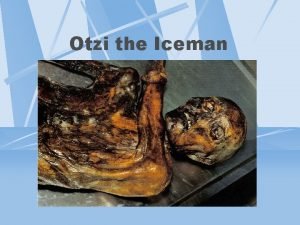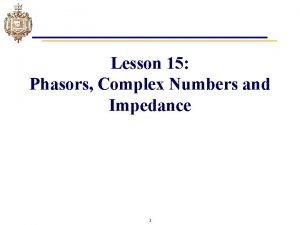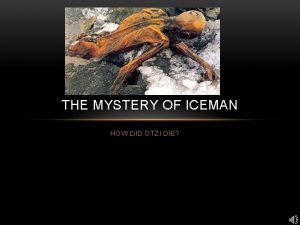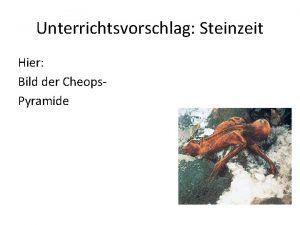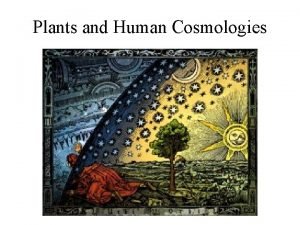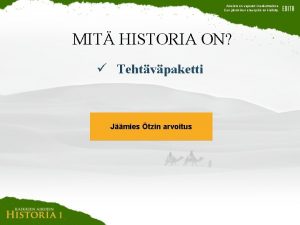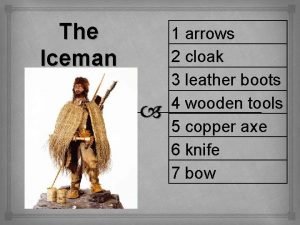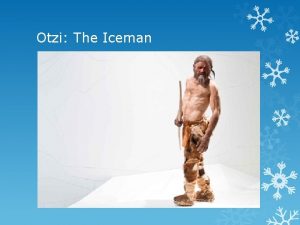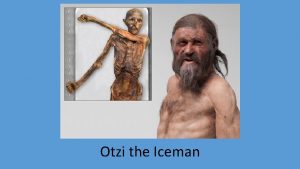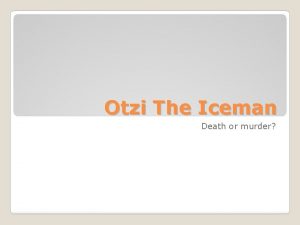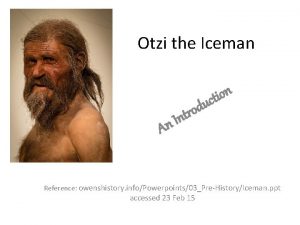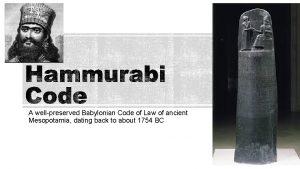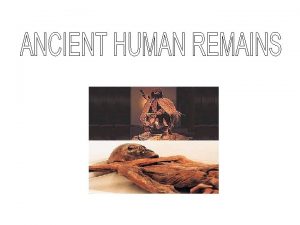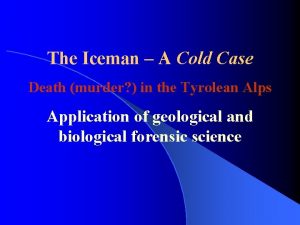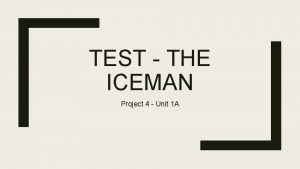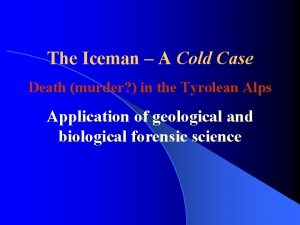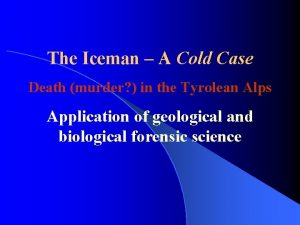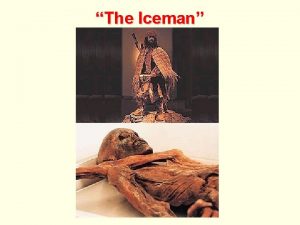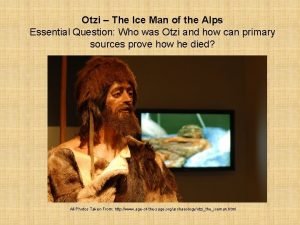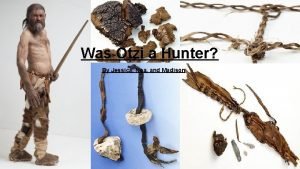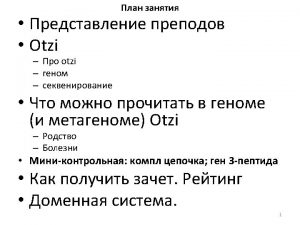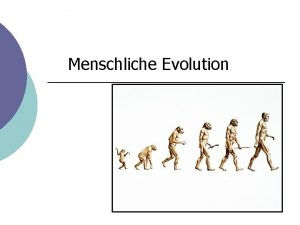The Iceman Otzi Introduction Otzi is a wellpreserved





































- Slides: 37

The Iceman Otzi

Introduction Otzi is a well-preserved natural mummy of a Chalcolithic (Copper Age) man from about 3300 BC. On September 19, 1991 two German tourists climbing in the Ötztal Alps, near the border between Austria and Italy discovered a frozen body emerging from the glacier. This frozen body would become known as the Iceman, and be one of the most exciting scientific discovery of its time.

Discovering the Iceman Because of its state of preservation, the body was at first thought to be a modern corpse, like several others which had been recently found in the region. Before the body was removed from the ice, people were allowed to see it, and some took portions of the clothing and tools as souvenirs.


Ötzi the Iceman while still frozen in the glacier, photographed by Helmut Simon upon the discovery of the body in September 1991


Another early photograph of the body before its removal from the ice.

Discovering the Iceman Lying on its front and frozen in ice below the torso, it was crudely removed from the glacier by the Austrian authorities using a small jackhammer (which punctured the hip of the body) and ice-axes using nonarchaeological methods. The body was then taken to a morgue in Innsbruck, where its true age was subsequently ascertained.


Damage caused by small jack hammer to Otzi’s hip when authorities attempted to remove his body from the ice.

The Body Ötzi was approximately 1. 65 metres (5 ft 5 in) tall and weighed about 50 kilograms. He was about 45 years of age. The body has been extensively examined, measured, X-rayed, and dated. Tissues and intestinal contents have been examined microscopically, as have the items found with the body.


An early x-ray of Otzi


The Body – Stomach Contents Analysis of Ötzi's intestinal contents showed his last meals (the last one about eight hours before his death), the most recent of red deer meat. There was also some grain as well as some roots and fruits. The grain was a highly processed wheat bran, quite possibly eaten in the form of bread. Also, pollen grains of hop-hornbeam were discovered. The pollen was very well preserved, indicating that it had been fresh (a few hours old) at the time of Ötzi's death, which places his death in the spring.

The Body - Health Ötzi had whipworm, an intestinal parasite. During CT scans, it was observed that three or four of his right ribs had been squashed when he had been lying face down after death, or where the ice had crushed his body. His fingernail (only one was found) indicates he was sick three times in the six months before he died.

Whipworm found in Otzi’s intestines

The Body - Tatoos Ötzi had approximately 57 carbon tattoos consisting of simple dots and lines on his lower spine, behind his left knee, and on his right ankle. Using X-rays, it was determined that the Iceman may have had arthritis in these joints. It has been speculated that they may be related to acupuncture


Clothes Ötzi's clothes were sophisticated. He wore: ◦ cloak made of woven grass and a coat ◦ a belt, a pair of leggings ◦ a loincloth made of leather of different skins. ◦ He also wore a bearskin cap with a leather chin strap. ◦ Shoes made of bearskin for the soles, deer hide for the top panels, and a netting made of tree bark. Soft grass went around the foot and in the shoe and functioned like modern socks.




Clothes The coat, belt, leggings, and loincloth were constructed of vertical strips of leather sewn together with sinew. His belt had a pouch sewn to it that contained useful items: a scraper, drill, flint flake, and a dried fungus to be used as tinder. His shoes were waterproof and wide, designed for walking across snow

Items Found with the Iceman 10/31/2020 Unfinished Bow Axe Backpack Ibex bones Two birch containers Dagger with scabbard Retoucher Belt pouch and contents Two pieces of fungi Tassel with marbel bead A net of grass string Quiver and aroows

Unfinished Bow, Quiver & Arrows 182 cms long bow Quiver had 2 arrows ready to use and 12 partly completed shafts

Copper Axe Skin binding copper blade to yew handle. Only prehistoric axe ever found intact.

Dagger with scaabbard Ash wood handle bound with animal sinew with flint blade. Scabbard of grass cord and leather strap

Retoucher Like a stubby pencil. Stag antler set into wooden handle. Used to sharpen flint tools.

Birch fungi Antibiotic – a travelling medical kit?

Reconstructions of the Iceman

Questions…. . Who was Otzi? What was his occupation? (What did he do? ) What was he doing in the mountains? What can Otzi teach us about society in Europe during the Chalcolithic (Copper Age) period? How did he die?


Theory #1 – Hypothermia (Froze to Death) Theory #1: Hypothermia (Froze to Death) 1. His body was so well preserved that most scientists think that he froze quickly after his death. The cold turned his body into a mummy with yellow, leathery skin. 2. Because the weather can change so quickly in the Alps, some scientists believe that Otzi could have died of hypothermia. Hypothermia occurs when the body temperature drops significantly. In other words, many think that Otzi froze to death. 3. Many claim that it is easy to get lost in the Alps. Perhaps Otzi lost his way and froze to death? 4. Otzi’s muscle tissue was badly decomposed, as was the outer layer of his skin. This can happen when a body is submerged in very cold water. Did Otzi fall through thin ice and into water and was not able to escape? 5. When suffering from hypothermia, sometimes a warm sensation can overcome a person’s body. Otzi was found without his shoes on. Did he remove his clothing as he felt this warming sensation of hypothermia?

Theory #2 – Victim of Robbery 1. Many villagers back then were shepherds. Was Otzi a shepherd too? Otzi had on a cloak and leggings that would have kept him warm in the Alps as he was moving his flock. 2. During that time of year, it was common for shepherds to move their flock to pastures in the Alps. Was Otzi in the mountains at the time with his flock? 3. Otzi had pollen in his stomach. This pollen is fond in the spring on trees were shepherds commonly led their flocks. Was Otzi leading sheep through this path? 4. A one-inch arrowhead made from flint was found in the iceman’s left shoulder. The arrowhead tore through the nerves and blood vessels, shattering his shoulder blade and paralyzing his left arm. There are signs of heavy internal bleeding. Medical examiners have determined that the iceman died probably three hours after he was shot with the arrow and that his death was probably very painful. 5. The robbers saw his flock and wanted it for their own profit. When Otzi saw the men coming after him, he ran away. Did the robbers pursue him and shoot him in the back with an arrow, kill him, and then take his sheep?

Theory #3 – Assassainated 1. Otzi’s joints had very little deterioration, which means he probably did not perform many physical tasks. What kind of job did Otzi have? Was Otzi a community or religious leader? 2. Otzi could have been assassinated in a power-play conflict. He did not suspect the arrow that came from behind. Did some of the village people not like his politics or religious service to the community? Maybe one of his followers had a disagreement with him and murdered him. 3. Otzi also had some mushrooms know for their medicinal value. Was he a medicine man, or a religious leader who used his powers to heal people? 4. Otzi had mysterious tattoos on his body. Did these markings have religious significance? Was he a religious leader? 5. Copper axes were valuable and a sign of power. Some say that only a leader would own an axe like this one.

Theory #4 – Died in Battle 1. There was an intense border dispute between the people at that time, and a battle occurred to solve it. Otzi may have fount in this battle. 2. DNA samples were gathered from Otzi’s weapons, clothing, and tools. Blood from four different people was found on these items. The blood found on his dagger was from one individual. Blood from two individuals was found on his arrow. On his coat was another individuals blood. How did this blood get there? 3. Did Otzi carry an injured companion to safety before being killed himself? His injured friend bled onto his coat as he was carried. Perhaps he carried multiple wounded friends to safety? 4. Otzi used his two good arrows to kill two others in some sort of boundary dispute. He retrieved these arrows and was trying to fix his other arrows for another attack. Before he could do so, he was shot in the back. (Arrowhead found in his shoulder blade) 5. Before he died, Otzi arranged his belongings on the ledge around him and then slumped over.
 Otzi the iceman robbery theory
Otzi the iceman robbery theory Eli the iceman
Eli the iceman Autzi ecommerce
Autzi ecommerce Complex impedance formula
Complex impedance formula How did otzi die
How did otzi die ötzi steckbrief arbeitsblatt
ötzi steckbrief arbeitsblatt Halbwertszeit ötzi
Halbwertszeit ötzi Otzi
Otzi Coca plant tattoo
Coca plant tattoo ötzi kengät
ötzi kengät Heimatpower
Heimatpower Otzi battle theory
Otzi battle theory Viking bear skin cloak
Viking bear skin cloak Hình ảnh bộ gõ cơ thể búng tay
Hình ảnh bộ gõ cơ thể búng tay Slidetodoc
Slidetodoc Bổ thể
Bổ thể Tỉ lệ cơ thể trẻ em
Tỉ lệ cơ thể trẻ em Chó sói
Chó sói Tư thế worm breton là gì
Tư thế worm breton là gì Bài hát chúa yêu trần thế alleluia
Bài hát chúa yêu trần thế alleluia Môn thể thao bắt đầu bằng từ đua
Môn thể thao bắt đầu bằng từ đua Thế nào là hệ số cao nhất
Thế nào là hệ số cao nhất Các châu lục và đại dương trên thế giới
Các châu lục và đại dương trên thế giới Cong thức tính động năng
Cong thức tính động năng Trời xanh đây là của chúng ta thể thơ
Trời xanh đây là của chúng ta thể thơ Mật thư anh em như thể tay chân
Mật thư anh em như thể tay chân 101012 bằng
101012 bằng Phản ứng thế ankan
Phản ứng thế ankan Các châu lục và đại dương trên thế giới
Các châu lục và đại dương trên thế giới Thơ thất ngôn tứ tuyệt đường luật
Thơ thất ngôn tứ tuyệt đường luật Quá trình desamine hóa có thể tạo ra
Quá trình desamine hóa có thể tạo ra Một số thể thơ truyền thống
Một số thể thơ truyền thống Cái miệng nó xinh thế chỉ nói điều hay thôi
Cái miệng nó xinh thế chỉ nói điều hay thôi Vẽ hình chiếu vuông góc của vật thể sau
Vẽ hình chiếu vuông góc của vật thể sau Nguyên nhân của sự mỏi cơ sinh 8
Nguyên nhân của sự mỏi cơ sinh 8 đặc điểm cơ thể của người tối cổ
đặc điểm cơ thể của người tối cổ V cc cc
V cc cc Vẽ hình chiếu đứng bằng cạnh của vật thể
Vẽ hình chiếu đứng bằng cạnh của vật thể


